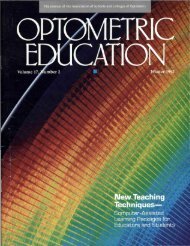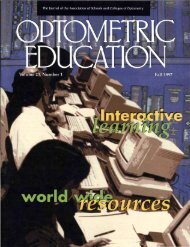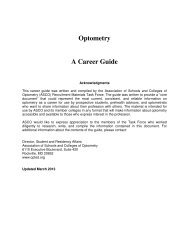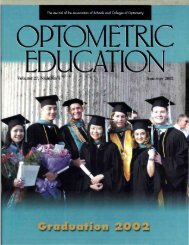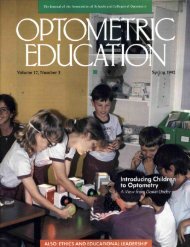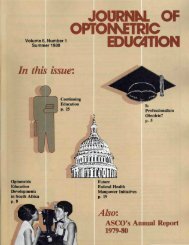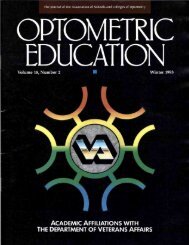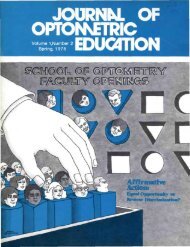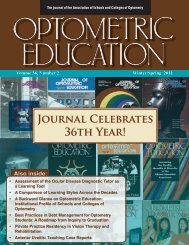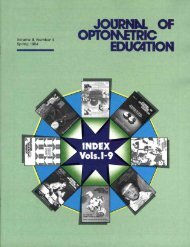Summer 2012, Volume 37, Number 3 - Association of Schools and ...
Summer 2012, Volume 37, Number 3 - Association of Schools and ...
Summer 2012, Volume 37, Number 3 - Association of Schools and ...
Create successful ePaper yourself
Turn your PDF publications into a flip-book with our unique Google optimized e-Paper software.
Idiopathic Intracranial<br />
Hypertension:<br />
A Teaching Case Report<br />
Aurora Denial, OD, FAAO<br />
Nancy B. Carlson, OD, FAAO<br />
Abstract<br />
Idiopathic intracranial hypertension (IIH), previously known as pseudotumor<br />
cerebri, is a condition <strong>of</strong> increased intracranial pressure <strong>of</strong> unknown etiology.<br />
The most common ocular sign <strong>of</strong> the disorder is bilateral optic disc edema. Early<br />
<strong>and</strong> appropriate diagnosis <strong>and</strong> effective management are crucial. This teaching<br />
case report will highlight the overall role <strong>of</strong> the primary care optometrist in the<br />
diagnosis <strong>and</strong> management <strong>of</strong> a patient with IIH. The case specifically deals with<br />
the challenges involved in delivering bad or upsetting news to patients, the facilitation<br />
<strong>of</strong> communication, both interpr<strong>of</strong>essional <strong>and</strong> doctor/patient, <strong>and</strong> the<br />
critical thinking skills needed for accurate patient management.<br />
Key Words: idiopathic intracranial hypertension, pseudotumor cerebri, primary<br />
care, optometrist<br />
Dr. Denial is an Associate Pr<strong>of</strong>essor <strong>of</strong> Optometry at the New Engl<strong>and</strong> College <strong>of</strong> Optometry <strong>and</strong><br />
a clinical instructor in the Boston area.<br />
Dr. Carlson is a Pr<strong>of</strong>essor <strong>of</strong> Optometry at the New Engl<strong>and</strong> College <strong>of</strong> Optometry <strong>and</strong> Chair <strong>of</strong><br />
the Department <strong>of</strong> Primary Care.<br />
Background<br />
This case involves a <strong>37</strong>-yearold<br />
African American female<br />
who is diagnosed with idiopathic<br />
intracranial hypertension<br />
(IIH). IIH, previously known as<br />
pseudotumor cerebri or benign intracranial<br />
hypertension, is a condition<br />
<strong>of</strong> increased intracranial pressure <strong>of</strong><br />
unknown etiology. 1 Symptoms <strong>of</strong>ten<br />
include headache, nausea <strong>and</strong> pulsating<br />
sounds within the head. The most<br />
significant ocular sign is optic disc<br />
edema. 2 The greatest consequence <strong>of</strong><br />
the bilateral optic disc edema in IIH is<br />
vision loss. 3 Up to 25% <strong>of</strong> IIH patients<br />
will develop permanent vision loss. 4<br />
Persistent headaches, depression, anxiety,<br />
reduced quality <strong>of</strong> life, <strong>and</strong> loss <strong>of</strong><br />
vision are <strong>of</strong>ten long-term consequences<br />
<strong>of</strong> the condition. 5 The economic cost<br />
<strong>of</strong> this condition is significant <strong>and</strong> estimated<br />
to exceed $444 million annually<br />
in the United States. 6<br />
This teaching case report will highlight<br />
the overall role <strong>of</strong> the primary care<br />
optometrist in the management <strong>of</strong> a<br />
patient with IIH. The case specifically<br />
deals with the challenges involved in<br />
delivering serious or upsetting news,<br />
the facilitation <strong>of</strong> communication,<br />
both interpr<strong>of</strong>essional <strong>and</strong> doctor/patient,<br />
<strong>and</strong> the critical thinking skills<br />
needed for accurate patient management.<br />
It is appropriate for use with students<br />
who have had at minimum some<br />
patient care experience <strong>and</strong> knowledge<br />
in ocular <strong>and</strong> neuroanatomy <strong>and</strong> ocular<br />
disease. At most colleges, it would be<br />
appropriate for third- <strong>and</strong> fourth-year<br />
optometry students. Optic disc edema<br />
can indicate a potentially life- or sightthreatening<br />
condition; therefore, early<br />
<strong>and</strong> appropriate diagnosis along with<br />
effective patient management is crucial.<br />
Student Discussion Guide<br />
Case description<br />
Patient PC, a <strong>37</strong>-year-old African<br />
American female, presented to a community<br />
health center eye clinic for a<br />
comprehensive eye exam on May 3,<br />
2011. The community health center<br />
provides medical, eye, dental, mental<br />
health, urgent care <strong>and</strong> nutritional ser-<br />
Optometric Education 115 <strong>Volume</strong> <strong>37</strong>, <strong>Number</strong> 3 / <strong>Summer</strong> <strong>2012</strong>



